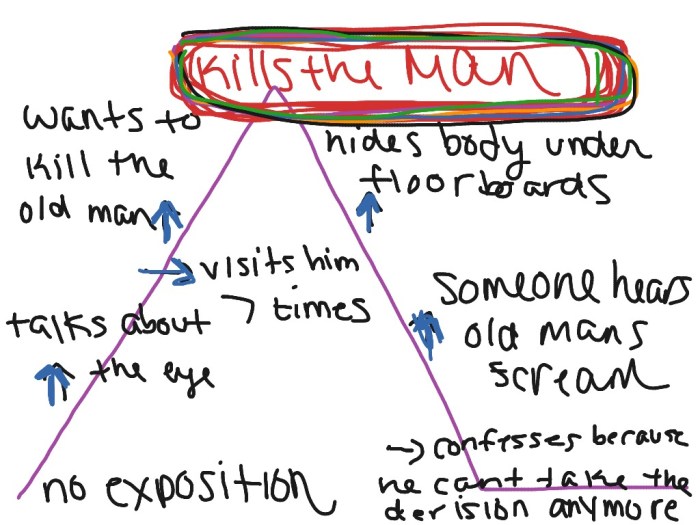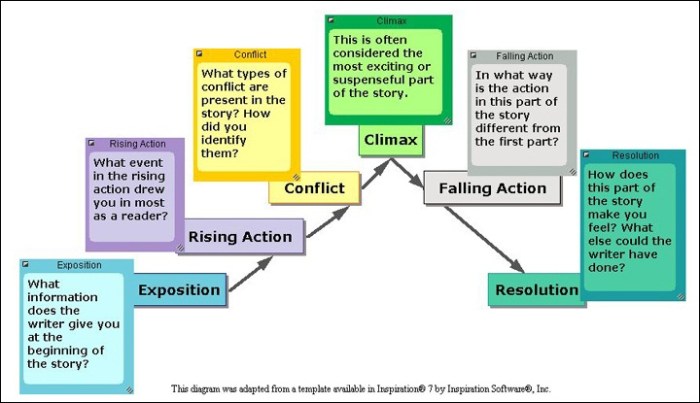Tell tale heart plot diagram – Delve into the intricacies of Edgar Allan Poe’s “The Tell-Tale Heart” through our comprehensive plot diagram. This guide will dissect the story’s structure, exploring the key events, conflicts, and themes that drive this haunting masterpiece.
As we unravel the plot diagram, we’ll uncover the narrator’s descent into madness, the symbolism embedded within the tale, and the psychological impact of guilt and paranoia.
Introduction
The Tell-Tale Heart is a classic short story by Edgar Allan Poe that follows the deteriorating mental state of an unnamed narrator who murders an old man because of his “vulture eye.”
A plot diagram is a visual representation of the key events in a story. It helps readers understand the structure and progression of the plot and identify its main elements, such as the exposition, rising action, climax, falling action, and resolution.
Exposition
The exposition introduces the characters, setting, and background information. In The Tell-Tale Heart, the narrator describes his intense hatred for the old man and his vulture eye.
Rising Action

The rising action of “The Tell-Tale Heart” begins with the inciting incident: the narrator’s intense hatred for the old man’s “vulture eye.”
The narrator’s obsession with the eye leads to a series of increasingly erratic actions. He stalks the old man, observing his every move. The tension escalates as the narrator’s fear and guilt grow.
Narrator’s Actions and Motivations
- Stalking:The narrator’s constant surveillance of the old man intensifies the tension and creates a sense of impending doom.
- Fear and Guilt:The narrator’s fear of the old man’s eye and the guilt he feels over his own actions drive him to the brink of madness.
- Delusions and Hallucinations:The narrator’s obsession leads to delusions and hallucinations, further fueling his irrational behavior.
Climax

The climax of “The Tell-Tale Heart” occurs when the protagonist confesses his crime to the police officers who have come to investigate the commotion. Driven by guilt and paranoia, he reveals the details of how he meticulously planned and executed the murder of the old man, including the removal of the old man’s eye and the subsequent dismemberment of the body.
The protagonist’s actions and choices have led him to this point of no return. His obsessive focus on the old man’s “vulture eye” and his fear of being exposed have consumed him, driving him to commit a heinous crime. The climax marks the moment when the protagonist’s carefully constructed facade crumbles, exposing the truth of his guilt and the depths of his madness.
Emotional and Psychological Impact
The climax of the story has a profound emotional and psychological impact on the characters involved.
- Protagonist:The protagonist experiences a sense of relief and release as he confesses his crime, but it is quickly replaced by a crushing weight of guilt and despair. He realizes the gravity of his actions and the irreparable damage he has caused.
- Police officers:The police officers are initially skeptical of the protagonist’s confession, but as he continues to provide increasingly detailed and incriminating information, they are forced to confront the reality of the situation. They are shocked and horrified by the protagonist’s actions and the extent of his madness.
- Audience:The climax of the story leaves the audience with a sense of unease and discomfort. They are left to grapple with the protagonist’s descent into madness and the consequences of his actions. The story raises questions about the nature of guilt, the fragility of sanity, and the darkness that can lurk within the human heart.
Falling Action

In the falling action, the events following the climax unravel the consequences of the protagonist’s actions and lead towards the resolution.
The Tell-Tale Heart plot diagram’s rising action, climax, and falling action depict the narrator’s descent into madness. His obsession with the old man’s “vulture eye” parallels the life of Andrew Babbitt, a figure from Ocala, whose unwavering determination led to a pivotal event in andrew babbitt city of ocala . Just as the narrator’s actions culminate in a violent confrontation, so too did Babbitt’s resolve shape his destiny.
The Tell-Tale Heart plot diagram serves as a reminder that even seemingly insignificant obsessions can have far-reaching consequences.
The protagonist, consumed by guilt and paranoia, confesses his crime to the police. The police officers, skeptical initially, discover the old man’s dismembered body under the floorboards, confirming the narrator’s confession.
Arrest and Imprisonment
- The protagonist is arrested and imprisoned, facing the legal consequences of his actions.
- His confession exposes his deteriorating mental state and the delusions that drove him to murder.
Theme and Character Arc
The falling action reinforces the theme of guilt and the consequences of obsession. The protagonist’s descent into madness and his ultimate downfall highlight the destructive power of unchecked emotions.
The character arc completes with the protagonist’s confession and imprisonment, marking a tragic end to his life. His actions and their repercussions serve as a cautionary tale about the dangers of obsession and the importance of confronting one’s inner demons.
Resolution

The resolution of “The Tell-Tale Heart” brings the story to its chilling conclusion. The narrator, driven by guilt and paranoia, finally confesses his crime to the police, who arrest him. The story ends with the narrator’s last words, a haunting echo of his obsessive guilt: “Here, here! It is the beating of his hideous heart!”
The ending is significant in several ways. First, it reveals the true extent of the narrator’s madness. He has become so consumed by his guilt that he can no longer distinguish between reality and his own delusions. The beating of his own heart becomes a constant reminder of his crime, driving him to confess and ultimately to his downfall.
The resolution also contributes to the overall meaning and message of the story. Poe explores the destructive power of guilt and the dangers of allowing oneself to be consumed by fear and paranoia. The narrator’s obsession with the old man’s “vulture eye” becomes a symbol of his own inner demons, which ultimately lead to his downfall.
Symbolism and Themes: Tell Tale Heart Plot Diagram

The “Tell-Tale Heart” employs various symbols and motifs that enhance the story’s psychological depth and contribute to the development of its central themes.
The Beating Heart
The beating heart, both literal and metaphorical, serves as a central symbol. Its relentless pounding represents the narrator’s guilt and paranoia, as it symbolizes his conscience that he cannot escape.
Character Analysis

The main characters in “The Tell-Tale Heart” are the unnamed narrator and the old man he kills. The narrator is a young man who is deeply obsessed with the old man’s “vulture eye.” He believes that the eye is evil and that it is driving him insane.
The old man is a frail and helpless old man who is completely unaware of the narrator’s hatred for him.
The narrator’s actions are driven by his obsession with the old man’s eye. He stalks the old man for days, waiting for the perfect opportunity to kill him. When he finally does kill the old man, he dismembers the body and hides the pieces under the floorboards.
However, the narrator’s guilt and paranoia eventually get the better of him, and he confesses his crime to the police.
Throughout the story, the narrator’s character undergoes a significant transformation. He begins as a seemingly rational and sane individual, but his obsession with the old man’s eye gradually drives him to madness. By the end of the story, he is a raving lunatic who is unable to control his own actions.
The Narrator, Tell tale heart plot diagram
- A young man who is deeply obsessed with the old man’s “vulture eye.”
- Believes that the eye is evil and that it is driving him insane.
- Stalks the old man for days, waiting for the perfect opportunity to kill him.
- Dismembers the body and hides the pieces under the floorboards.
- Confesses his crime to the police.
The Old Man
- A frail and helpless old man who is completely unaware of the narrator’s hatred for him.
- Has a “vulture eye” that the narrator believes is evil.
- Is killed by the narrator.
FAQ Overview
What is the inciting incident in “The Tell-Tale Heart”?
The narrator’s growing obsession with the old man’s “vulture eye.”
How does the protagonist’s guilt contribute to the rising action?
His guilt intensifies his paranoia and leads him to make reckless decisions.
What is the significance of the climax in the plot diagram?
It marks the point of no return, where the protagonist’s madness and guilt overwhelm him.

